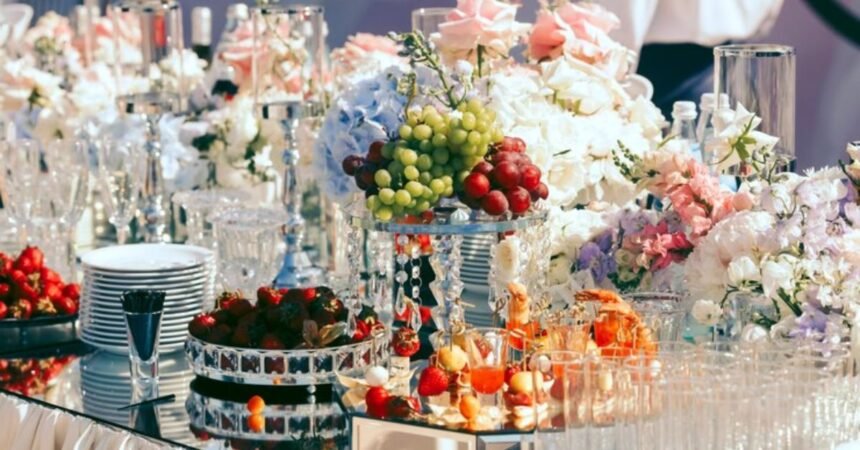Centerpieces at Wedding Receptions NYT play a crucial role in setting the mood and ambiance of the event. These decorative elements not only enhance the visual appeal of the tables but also reflect the couple’s personality and style. According to The New York Times, wedding centerpieces have evolved significantly over the years, blending tradition with modern creativity. This article will explore the importance of centerpieces at wedding receptions, highlight popular trends, and offer practical tips to help you create a stunning, memorable table arrangement. Whether you’re planning a large wedding or an intimate gathering, the right centerpiece can make all the difference.
Understanding Centerpieces at Wedding Receptions NYT
What Are Centerpieces?
Centerpieces are the focal point of each table at a wedding reception, designed to elevate the overall aesthetic. Typically placed in the center of the dining tables, they range from floral arrangements and candles to more creative displays featuring anything from personal keepsakes to elaborate art installations.
Traditionally, floral centerpieces have been the go-to choice for weddings. However, modern couples are increasingly opting for non-traditional items such as greenery, succulents, lanterns, or even interactive elements that allow guests to engage with the display.
Role of Centerpieces in Weddings
At wedding receptions, centerpieces serve both functional and aesthetic purposes. They help create a cohesive theme that ties together the ceremony and reception while also enhancing the dining experience for guests. Well-designed centerpieces contribute to the overall ambiance, transforming ordinary tables into luxurious settings.
Moreover, centerpieces can represent the couple’s journey, interests, or cultural background, providing a personal touch that resonates with guests. From rustic to glamorous, minimalist to extravagant, centerpieces offer limitless possibilities for customization.
Importance and Benefits of Centerpieces at Wedding Receptions NYT
Enhancing the Aesthetic Appeal
The primary function of centerpieces is to enhance the visual appeal of the reception area. Whether you’re hosting a grand ballroom reception or a laid-back garden party, centerpieces set the tone. They create a balance between elegance and comfort, ensuring that the décor complements the venue’s atmosphere.
Using the right centerpieces can also create a sense of depth and dimension in the room, making tablescapes more interesting. The aesthetic consistency between centerpieces and the overall theme contributes to a polished, well-thought-out design that guests appreciate.
Personalization and Storytelling
Centerpieces provide an excellent opportunity for couples to add personal touches to their wedding. By incorporating meaningful items such as family heirlooms, favorite flowers, or elements representing shared hobbies, couples can tell their unique story through their table décor.
For example, a couple who loves traveling might incorporate mini globes or souvenirs from their trips as part of their centerpiece. Those passionate about literature might opt for stacks of vintage books or custom quotes from their favorite authors. Personalizing centerpieces helps make the wedding more intimate and memorable for guests.
Functional Benefits
Beyond their decorative value, centerpieces serve practical purposes at wedding receptions. They help organize table settings, create conversation starters, and sometimes even double as guest favors. Interactive centerpieces, such as photo displays or mini gardens, invite guests to engage with the décor, fostering a lively and intimate atmosphere.
Additionally, centerpieces can guide seating arrangements and create a visual boundary between tables, giving guests a sense of personal space while dining. They also provide a focal point for photographers to capture stunning images of the reception.
Popular Centerpiece Trends at Wedding Receptions
Minimalist Elegance
Minimalist centerpieces are trending for couples who prefer a clean and sophisticated aesthetic. Think sleek vases with a few stems of greenery or single large blooms, such as peonies or hydrangeas. The New York Times reports that more couples are moving away from extravagant floral arrangements in favor of simpler, more understated designs that emphasize quality over quantity.
This trend reflects modern tastes for natural beauty and subtle elegance. Minimalist centerpieces also pair well with contemporary table settings, allowing other elements like table linens or place cards to stand out.
Bold and Bright Floral Arrangements
On the opposite end of the spectrum, some couples are choosing bold, statement-making floral arrangements. These centerpieces feature vibrant flowers in various hues, often paired with oversized greenery or exotic blooms. Bright florals create a sense of celebration and joy, perfect for couples who want their reception to feel festive and lively.
Flowers like roses, dahlias, and orchids are popular choices, offering both variety and vibrancy. Paired with lush greenery or metallic accents, these centerpieces can add depth and richness to the table décor.
Eco-Friendly and Sustainable Centerpieces
Sustainability is increasingly important to modern couples, and this value is reflected in their choice of wedding décor. Eco-friendly centerpieces, which prioritize sustainability, have gained traction in recent years. These may include potted plants, reusable materials, or locally sourced flowers to reduce the environmental impact of the wedding.
For example, succulents or small potted herbs can double as both centerpieces and take-home gifts for guests. Other couples opt for natural elements like driftwood, stones, or dried flowers, which can be repurposed or kept as mementos after the wedding.
Interactive Centerpieces
Interactive centerpieces are a creative trend that encourages guest participation. These might include items like Polaroid cameras, allowing guests to capture memories and leave photos at their table. Another fun option is to have games or puzzles that guests can interact with while they wait for food service.
Some couples use edible centerpieces, such as fruit or gourmet treats, that guests can enjoy during the reception. These interactive elements add a layer of fun and engagement to the event, making the centerpiece a talking point.
Candlelit Centerpieces
Candles have always been a staple in wedding décor, and they continue to be a popular choice for centerpieces. Whether you choose tall, elegant taper candles or clusters of small votives, candlelight adds warmth and romance to the reception.
Many couples combine candles with flowers, creating a harmonious blend of light and texture. Candlelit centerpieces work well for evening weddings, where the soft glow enhances the mood and creates a magical ambiance.
Applications and Use Cases for Centerpieces at Wedding Receptions NYT
Traditional Weddings
For traditional weddings, classic floral arrangements remain a favorite for centerpieces. These often feature elegant blooms like roses, lilies, or hydrangeas, arranged in ornate vases or decorative vessels. White, cream, and pastel colors dominate traditional weddings, creating an elegant and timeless look.
In such cases, centerpieces are typically symmetrical and polished, reflecting the formality of the event. Using complementary tableware and linens enhances the classic feel, making the entire reception visually cohesive.
Rustic and Outdoor Weddings
At rustic or outdoor weddings, centerpieces tend to feature more natural elements. Think of mason jars filled with wildflowers, wooden boxes with greenery, or lanterns surrounded by greenery and candles. These centerpieces align with the laid-back and natural vibe of outdoor or barn weddings, blending seamlessly with the surrounding environment.
Rustic centerpieces often incorporate DIY elements, such as hand-painted vases or repurposed items. This personalized approach adds charm and makes the décor feel authentic and homey.
Modern and Urban Weddings
Modern weddings often push the boundaries of traditional décor, and this extends to centerpieces. Geometric shapes, metallic finishes, and monochromatic color schemes are popular in modern centerpieces. Clear acrylic vases, black-and-white accents, or sleek candles are often chosen to complement the contemporary style.
At urban weddings, centerpieces can be minimalist and chic, featuring unique materials like concrete planters or industrial elements. These designs cater to couples who prefer clean lines and a modern aesthetic.
Cultural Weddings
Cultural weddings often incorporate specific symbolic elements into their centerpieces. For example, in Indian weddings, marigolds or jasmine flowers are commonly used to symbolize happiness and prosperity. In Chinese weddings, red and gold are frequently used to represent luck and wealth.
By incorporating cultural symbols, couples can honor their heritage while also enhancing the beauty of their tablescapes. Such centerpieces often become focal points of the event, adding a deep layer of meaning to the celebration.
Challenges of Choosing Centerpieces at Wedding Receptions
Balancing Style and Budget
One of the most common challenges couples face is balancing their desired style with their budget. Floral centerpieces, especially those featuring exotic blooms or custom arrangements, can be expensive. Couples on a tight budget might find it challenging to achieve the look they want without overspending.
Ensuring Centerpieces Don’t Obstruct Conversations
Large or tall centerpieces, while dramatic, can sometimes obstruct the view between guests, making it difficult for them to engage in conversation. It’s important to strike a balance between aesthetic impact and functionality, ensuring that centerpieces enhance the table without creating barriers.
Keeping the Theme Consistent
Another challenge is maintaining consistency between the centerpieces and the overall wedding theme. Sometimes, couples choose centerpieces that clash with the rest of the décor, resulting in a disjointed look. Ensuring that the color palette, materials, and style of the centerpieces align with the wedding’s theme is key to creating a cohesive design.
Solutions and Tips for Overcoming Centerpiece Challenges
Opt for Budget-Friendly Alternatives
If you’re working with a tight budget, consider using in-season flowers or greenery, which tend to be more affordable. You can also reduce costs by incorporating non-floral elements like candles, lanterns, or repurposed items from your home. Renting centerpieces is another option, allowing you to achieve a high-end look without purchasing items outright.
Choose Low or High-Profile Centerpieces
To ensure conversations flow smoothly at the table, choose either low-profile centerpieces that sit close to the table or high-profile ones that are tall enough to clear the line of sight. Both options add height and dimension to the tables without obstructing the view between guests.
Work with a Wedding Planner or Florist
A professional wedding planner or florist can help you select centerpieces that fit your theme and budget. They can also provide insights on how to achieve the most visual impact without overwhelming the space or clashing with other décor elements.
Conclusion
Centerpieces at Wedding Receptions NYT are more than just decorative elements—they play a key role in setting the mood, telling the couple’s story, and enhancing the overall experience for guests. From minimalist arrangements to bold floral displays, there are endless possibilities when it comes to designing the perfect centerpiece. By understanding the trends, benefits, and challenges of wedding centerpieces, couples can create beautiful, cohesive table settings that elevate their reception.
FAQs
1. What are the most popular types of centerpieces at wedding receptions?
Floral arrangements, candlelit displays, and eco-friendly designs are some of the most popular choices for centerpieces at weddings.
2. How can I create a budget-friendly centerpiece?
Consider using in-season flowers, greenery, or non-floral items like candles or lanterns to save costs.
3. What centerpiece style works best for a rustic wedding?
Rustic weddings often feature natural elements like wooden boxes, mason jars, or wildflowers to match the outdoor, laid-back setting.
4. How can I ensure my centerpieces don’t block guests’ view?
Opt for low-profile centerpieces or tall arrangements that clear the line of sight to encourage easy conversations between guests.
5. How do I personalize my wedding centerpieces?
Incorporate meaningful items, such as family heirlooms, shared hobbies, or cultural symbols, to give your centerpieces a personal touch.








